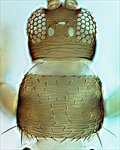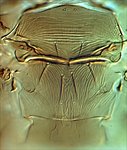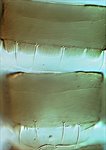
lobatus head & pronotum

lobatus meso & metanota

lobatus tergites VII-X

lobatus sternites VI-VII

lobatus sternite IV
Generic diagnosis
Macropterous. Head slightly wider than long; maxillary palps 3-segmented; eyes without pigmented facets; ocellar setae I absent, setae II shorter than III; five pairs of postocular setae. Antennae 7- or 8-segmented; segment I without paired dorso-apical setae, III and IV with sense-cones forked, III–VI with rows of microtrichia on both surfaces. Pronotum with two pairs of posteroangular setae; three to five pairs of posteromarginal setae. Mesonotum with median pair of setae far from posterior margin; anteromedian campaniform sensilla present. Metanotum with longitudinal striae or weak reticulation, with small lines between striae or within reticulations; campaniform sensilla present. Fore wing first vein with long gap in setal row, usually seven basal and two distal setae, second vein with many equally spaced setae; clavus usually with five veinal and one discal setae; posterior fringe cilia wavy. Prosternal ferna weakly connected medially; basantra with a few microtrichia but no setae. Mesosternum with sternopleural sutures complete; endofurca with spinula; spinasternum broad and transverse. Metasternal endofurca without spinula. Tarsi 2-segmented. Tergite II with three lateral marginal setae; tergites IV–VIII with lateral ctenidia, on VIII mesad of spiracles; tergites II–VII with broad craspeda; tergite VIII with long, fine and complete comb, arising from broad craspedum; IX with MD setae well developed, two pairs of campaniform sensilla present; X with median split almost complete; sternites II–VII with lobate posteromarginal craspeda, on VII with a few teeth laterally but no craspedum medially; III–VII with three pairs of posteromarginal setae, II with two pairs, VII with S1 in front of posterior margin. laterotergites II–VII with craspeda and one to four discal setae.
Male similar to female; tergite VIII without posteromarginal comb; IX with broad craspedum; tergum X with pair of campaniform sensilla; sternites II–VIII with lobate posteromarginal craspeda with fine teeth; sternites III–VI with transverse pore plates.
Biological data
Adults of the four species in this genus have been taken from the flowers and leaves of many different and unrelated plant species, with little evidence of any specificity.
Distribution data
The members of this genus are found across Asia between India and northern Australia (Masumoto & Okajima, 2002).
Nomenclatural data
Thrips (Ernothrips) Bhatti, 1967: 18. Type species Thrips (Ernothrips) lobatus Bhatti, 1967, by monotypy.
Four species are recognised in this genus (ThripsWiki, 2020), with two recorded from China:
lobatus (Bhatti, 1967: 18). (Thrips, Ernothrips)
longitudinalis Zhou Zhang & Feng, 2008: 94.
Relationship data
Thripidae sub-family Thripinae: this is a diverse group involving more than 230 genera. Within this large group, Ernothrips is a member of the Thrips genus-group (Mound, 2002), and shares many character states with species of Thrips genus. However, Ernothrips species have a craspedum on the abdominal tergites and sternites.
References
Masumoto M & Okajima S (2002) A revision of the genus Ernothrips Bhatti (Thysanoptera, Thripidae), with description of a new species from Thailand. Entomological Science 5 (1): 19–28.
Mound LA (2002) The Thrips and Frankliniella genus groups: the phylogenetic significance of ctenidia. Pp. 379–386 in Marullo R & Mound LA [eds] Thrips and Tospoviruses: Proceedings of the 7th International Symposium on Thysanoptera. Australian National Insect Collection, Canberra.
ThripsWiki (2020) ThripsWiki - providing information on the World's thrips. <http://thrips.info/wiki/Main_Page>